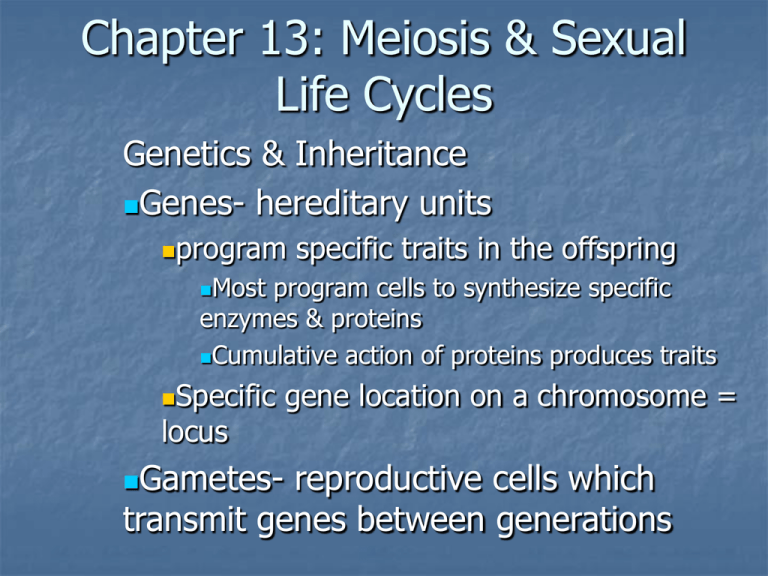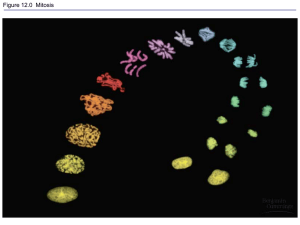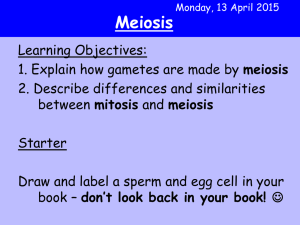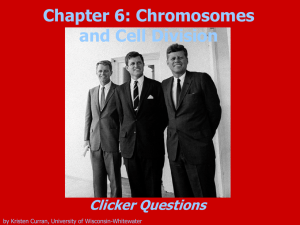
Chapter 13: Meiosis & Sexual
Life Cycles
Genetics & Inheritance
Genes- hereditary units
program
specific traits in the offspring
Most
program cells to synthesize specific
enzymes & proteins
Cumulative action of proteins produces traits
Specific
locus
Gametes-
gene location on a chromosome =
reproductive cells which
transmit genes between generations
Asexual vs. Sexual Reproduction
Asexual Reproduction
All offspring’s genes originate from one parent
New offspring produced through mitosis
Sexual Reproduction
Offspring’s genes originate from two parents
Unique combinations of genes can be made
so that each offspring varies from its siblings
(exception- identical twins)
Fertilization & Meiosis alternate life
cycles
Life cycle
Generation-to generation sequence of stages in an
organism’s life from conception to reproduction
Example organism: Humans
Somatic cell (body cell) = 46 chromosomes
Homologous chromosomes = carry genes controlling
the same inherited trait
22 pairs of autosomes
1 pair of sex chromosomes
Diploid cells = have all chromosome sets (2n)
Haploid cells = have one chromosome from each set
(n); egg or sperm cells
Fertilization & Meiosis alternate life
cycles
Fertilization
Mitosis
Fusion of egg & sperm nuclei = zygote (2n)
Used to develop zygote into sexually mature adult;
Forms all somatic cells from zygote
Meiosis
Occurs in gonads
Reduces diploid number to half
Creates sperm & egg
Maintains diploid number for organisms; when
fertilization occurs the diploid number is restored
Sexual Life Cycles
Alternation of fertilization & meiosis is
characteristic of all sexually reproducing
organisms
Timing of fertilization & meiosis in the life
cycle varies between different species
Three types of sexual life cycles:
Animals
Gametes are only n cells
Gametes do not divide before fertilization
2n zygote divides by mitosis after fertilization
Three types of sexual life cycles
Alternation of generations
Plants & some algae
Has n & 2n multi-cellular stages
2n multi-cellular stage = sporophyte
Formed by ferilization of gametes
Makes spores by meiosis
n multi-cellular stage = gametophyte
Formed by mitosis of spores
Makes gametes by mitosis
Three types of sexual life cycles
Most fungi & some protists
Diploid zygote forms & immediately goes
through meiosis forming haploid cells
Haploid cells formed during meiosis divide by
mitosis to form a multi-cellular n adult
organism
n adult forms gametes through mitosis
Only 2n cell is the zygote
Concept Check
How does the karyotype of a human male
differ from that of a human female?
How does the alternation of meiosis &
fertilization in life cycles maintain the
normal chromosome number for that
species?
What process mitosis or meiosis is more
directly involved in gamete production:
In animals?
In plants & most fungi?
Meiosis
Has two
consecutive cell
divisions
Results in 4
haploid daughter
cells
Stages of Meiosis: Meiosis I
Prophase I
90% of meiosis spent in this phase
Chromosomes condense
Crossing over may occur between
homologous chromosomes
Synapsis occurs holding homologues together
Tetrads form
Nucleoli disperse; nuclear envelope
fragments; formation of spindles
Metaphase I
Tetrads arrange on metaphase plate
Stages of Meiosis: Meiosis I
Anaphase I
Chromosomes move toward poles (sister
chromatids still attached)
Telophase I & cytokinesis
In some species nuclear envelope & nucleoli
reform
Cleavage furrow (animals) or cell plate
(plants) forms
Stages of Meiosis: Meiosis II
No replication of chromosomes between
meiosis I & meiosis II
Prophase II
Metaphase II
Chromosomes position of metaphase plate
Anaphase II
Spindle apparatus forms
Sister chromatids move toward opposite poles
Telophase II & Cytokinesis
Nuclei form; chromosomes de-condense
Cleavage furrow or cell plate forms
Comparison of Mitosis & Meiosis
Meiosis reduces chromosome number by
half; mitosis conserves chromosome
number
Synapsis, crossing over, & tetrad formation
occur in prophase I of meiosis
Tetrads take position on metaphase plate
in metaphase I of meiosis
Homologues separate during anaphase I
of meiosis; sister chromatids remain
attached during meiosis I
Concept Check
Explain how mitosis conserves
chromosome number, while meiosis
reduces the chromosome number by half.
Compare the chromosomes present in
metaphase of mitosis to those in
metaphase II of meiosis.
Sexual Reproduction & evolution
Sexual reproduction produces genetic
variation which can contribute to evolution
Genetic variation
Mutations
Independent assortment
Crossing over
Random fertilization
Genetic Variation: independent
assortment
Random orientation of homologues during
metaphase I leads to unique combinations
of maternal & paternal chromosomes in
the egg & sperm
Genetic variation: crossing over
Allows genes to exchanged between
maternal & paternal chromosomes
creating unique chromosomes
Genetic Variation: random
fertilization
Each egg & sperm cell is unique
Which sperm fertilizes which egg
contributes to extreme variation among
offspring
2n = # of possible combinations per
gamete
Evolutionary Significance of Genetic
Variations
Populations evolve as a result of
differential reproductive success among its
variant members
Individuals with variations best suited to
the environment reproduce more thus
transmitting more of their genes
Success of variations dependant on
environment
Concept Check
In fruit flies 2n= 8, while in honeybees
2n=32. Assuming no crossing over, is
genetic variation higher among fruit flies
or honeybees? Explain.
When would crossing over not contribute
to increased genetic variation?
If a human cell had 22 autosomes & a Y
chromosome what kind of cell is it?
What is the immediate product of meiosis
in a plant?
What feature is unique to a plant life cycle
versus an animal life cycle?









